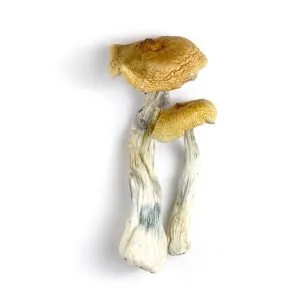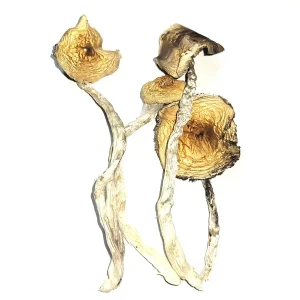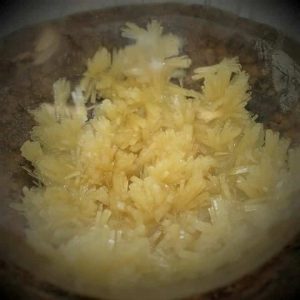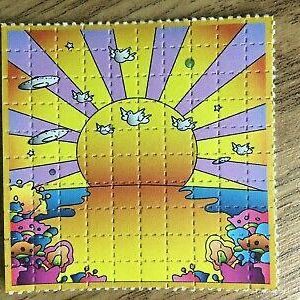PSILOCYBE CAERULIPES FOR SALE
Psilocybe Caerulipes was named after Andrew Weil — a famous natural health specialist who made a lot of contributions to the field of psychotherapy research. He’s known for his regular contributions to High Times magazine and wrote the forward for Paul Stamet’s book — Psilocybin Mushrooms of the World.
The psilocybin content of these mushrooms is moderate at around 0.6%.
WHAT IS PSILOCYBE CAERULIPES ?
Psilocybe caerulipes, also known as the Blue Foot Mushroom, is a rare psilocybin mushroom that grows in the US. It’s a wood loving mushroom and can be found growing on or around decaying hardwood logs, “especially near river systems,” writes Stamets. They can also be found growing on hardwood slash and debris, and are “widely distributed” east of the Great Plains throughout the Midwest and the Eastern US and up to Canada. “Although widely distributed, P. caerulipes is not found frequently,” writes Stamets. But when they grow on forest floors after warm summer and fall rains, they’re known to fruit in the same place for years. psilocybe caerulipes shroomery
Blue Foot mushrooms are named for their appearance: They have a blue-hue at the base of their stem. They are a moderately potent psilocybin mushroom, roughly the same strength as Psilocybe cubensis. Psillow warns that the experience could possibly be strong, so start small with one to three grams of dried mushrooms before diving into headier experiences. psilocybe caerulipes spore print
WHERE CAN I FIND PSILOCYBE CAERULIPES ?
If you live in the USA, Canada, Australia and UK P. caerulipes is a rare discovery. This mushroom grows especially well in subtropical and deciduous forests, especially those that are frequently logged and scattered with woody debris. You order or find Psilocybe Caerulipes mushroom online from PSYTTRAXX.
Psilocybe caerulipes Habitat
P. caerulipes is mostly found in forests of the Northeastern USA, with a few observations noted in Ontario, Canada. The mushroom has also been spotted in Mexico, around the state of Veracruz—but, thus far, not in any US states south of North Carolina. Most observations of P. caerulipes are clustered around Ohio, Pennsylvania, and New York, with a few observations recorded as far west as Michigan. psilocybe caerulipes potency
HOW STRONG IS PSILOCYBE CAERULIPES ?
Though psilocybin and psilocin were first detected in P. caerulipes in 1965, there were no studies of the precise potency of this mushroom until recently. A study published in 2022 analyzed two collections of this species and found that six-month-old, dry mushrooms contained a psilocybin concentration of around 0.2–0.6 percent and a psilocin concentration of around 0.05–0.3 percent. The scientists also found smaller concentrations of other alkaloids, such as aeruginascin (0.002–0.003 percent), baeocystin (0.006–0.01 percent), and norbaeocystin. (0.002–0.005 percent). psilocybe caerulipes blue-foot pictures
Though psilocybin and psilocin were first detected in P. caerulipes in 1965, there were no studies of the precise potency of this mushroom until recently. A study published in 2022 analyzed two collections of this species and found that six-month-old, dry mushrooms contained a psilocybin concentration of around 0.2–0.6 percent and a psilocin concentration of around 0.05–0.3 percent. The scientists also found smaller concentrations of other alkaloids, such as aeruginascin (0.002–0.003 percent), baeocystin (0.006–0.01 percent), and norbaeocystin. (0.002–0.005 percent). id psilocybe caerulipes
Blue-foot Psilocybe Growing Conditions
As a wood-loving species, P. caerulipes loves to grow on dead or dying wood, especially in birch, beech, or maple forests that are frequently logged and strewn with debris. The mushrooms might appear singly, though it’s more common to find them in dense clusters from either bare wood or wood covered by moss. It has a fairly wide growing season from early summer to late fall, or rarely, into early winter, especially after warm rains. how to find psilocybe caerulipes
Due to its rarity, there have been very few reports of growers deliberately cultivating this species. Attempts at indoor grows will likely follow the standard methods of growing spores on agar or grain. However, as P. caerulipes appears to be a wood-loving Psilocybe, their final bulk substrate should likely be mostly made of hardwood; mimicking their natural habitat and choosing woods like birch, beech or maple may also be a good choice to improve your chances of success.🍄 👁 🌈 ✨ psilocybe caerulipes east coast season
Those living in P. caerulipes’ native range of the Northeastern US would probably have good success growing these mushrooms outdoors in a shady, damp wood chip bed, ensuring regular watering during drier spells. Like other wood-loving Psilocybe species, blue foot Psilocybe should be fairly contamination resistant when grown outdoors.
If you do try your hand at growing P. caerulipes, you’ll likely be one of the first few to do so, but keep in mind that cultivating any psilocybin-containing species may be considered “manufacture” of psilocybin, which is illegal in many parts of the world. Always familiarize yourself with the laws in your area before cultivating psilocybin mushrooms.
Psilocybe caerulipes Identification
Part of P. caerulipes’ rarity might be due to its low-key appearance. These mushrooms usually grow no larger than around 2.5 inches tall and about 1.5 inches across the cap. Their dark brown and green-tinged color make them difficult to spot in their natural habitat of decaying wood and leaf litter. Like many other Psilocybe species, P. caerulipes mushrooms change to a lighter color when they dry out (hygrophanous), so a day or two of dry weather might make spotting this mushroom a little easier.
The gills of P. caerulipes are packed fairly tightly under the cap and attach to the stem either directly (adnate) or with a little notch (sinuate to uncinate). This mushroom’s gills start off a light brown color in younger shrooms and become a rusty ochre as they start to produce spores. The edges of the gills are almost white, and you might be able to see a few small hairlike projections—what mycologists call “fimbriated.”
The off-white stem of P. caerulipes has a powdery appearance near the cap, becoming darker brown and streaked with whitish-gray lines towards the base. It is on this stem where the classic blueing reaction can be most easily spotted—as with all psilocybin-containing mushroom species, blue color can be observed when damaged or dried. However, the intensity of the color change can vary between mushrooms and might take some time to appear.
Psilocybe caerulipes Spore Print
As with most Psilocybe species, the spores of P. caerulipes are a dark purplish brown. Due to this mushroom’s rarity, spore prints or syringes of the blue foot Psilocybe are not often found for sale online.
Psilocybe caerulipes Look-alikes
As a fairly inconspicuous mushroom, P. caerulipes may resemble many of what mycologists call the “little brown mushrooms” (LBMs), an informal group of different mushroom species. Some LBMs can be highly poisonous—even deadly—such as those in genera of Galerina, Cortinarius, Hypholoma, and Leratiomyces. This means that your identification skills need to be highly attuned if you’re planning on foraging P. caerulipes for consumption. As always, if you’re not 100 percent certain, leave those mushrooms alone!
In addition to being confused for little brown mushrooms, P. caerulipes is sometimes confused with other closely related Psilocybe species. Due to their similar geographic range and growing season, P. caerulipes is sometimes confused with the larger Psilocybe ovoideocystidiata. Compared to P. ovoideocystidiata, P. caerulipes is smaller, fruits later in the year, and its stem lacks an annulus—the ring of tissue on the stem that shows the remains of the veil that covers the gills of younger mushrooms.
6 Ways To Store Magic Mushrooms
There are many ways to store magic mushrooms.
If you want to get the maximum shelf-life from your shrooms — use a vacuum sealer with an oxygen absorber and desiccant and keep it in the freezer. You can store your shrooms for many years with this method.
1. How to Store Magic Mushrooms in Mason Jars
(6–12 months storage)
You can easily store your dried magic mushrooms in a mason jar.
The method is hands down the simplest and cheapest method — you can usually pick up a case of mason jars for just a couple of bucks. They’re designed to create an airtight seal to keep oxygen out of your container and slow the oxidation process that will degrade the potency of your shrooms.
For best results, store your mushroom mason jars in a cool, dry, dark place — such as a basement or cupboard. You can usually get around six months of storage with this method without any noticeable loss of potency. After this point, the shrooms will start to lose their potency.
By the 12 month mark, the shrooms will likely remain active, but there will be a noticeable drop in potency compared to mushrooms stored using more advanced techniques.
Tips for storing mushrooms in mason jars:
- Try and fill the mason jar as full as possible to reduce the amount of air contained inside
- Use oxygen absorbers and desiccants to prolong the shelf-life even further
- Always store mason jars out of direct light, and in a part of your home that’s cool and dry (bathrooms are a bad idea)
- Make sure the jar is sealed tight before you put it away for storage
- Avoid opening your mason jars as much as possible to avoid letting in fresh oxygen or potential contaminants
2. How To Store Magic Mushrooms in Ziplock Bags
(6-12 months storage)
Ziplock bags offer a similar level of protection as mason jars — but with some advantages and disadvantages.
The advantage of a ziplock bag is that you can squeeze out a good portion of the air in the bag before you seal it up. This will reduce the amount of oxygen inside that could potentially damage them and reduce the potency.
The downside of ziplock bags is that they can sometimes leak. If you don’t seal them up tightly or if a piece of mushroom gets caught in the seal, it can allow fresh oxygen to enter the bag while in storage — dramatically reducing the shelf-life.
Many people will first seal their shrooms in a ziplock bag and then place this in a mason jar for storage. The more layers of protection, the better.
Tips for storing mushrooms in ziplock bags:
- Use high-quality ziplock bags (double sealed and thicker plastic is ideal)
- Double bag your shrooms to be extra airtight
- Toss an oxygen absorber and desiccant to extend the shelf-life even further
- Squeeze as much of the air out of the bag as possible before storing it for extended periods
- Always keep your ziplock bag in a cool, dry, dark location
3. How to Store Magic Mushrooms in Chocolate
(6–18 months storage)
Chocolate is a surprisingly great tool for preservation. You can make your own psilocybin chocolates by grinding your dried shrooms into a powder, melting some chocolate on the stove (dark chocolate stores the longest), and mixing in your powdered mushrooms as the chocolate is cooling.
It’s important not to heat the mushrooms directly as this will inadvertently damage the active ingredients and defeat the purpose of storing them this way in the first place. Add the powder as the chocolate is cooling down, and you’ll avoid damaging the psilocybin.
Chocolate will seal the magic mushrooms suspended inside from the elements. It blocks UV light and oxygen, which are the primary causes for mushrooms to go bad.
Tips for storing magic mushrooms in chocolate:
- Add the powdered shrooms as the chocolate is cooling (don’t heat them directly)
- Wrap each chocolate in tin foil and store in an airtight container in the fridge
- Avoid opening the chocolates or touching them before you’re ready to eat them
- Opt for dark chocolate with the least amount of sugar possible to get the longest shelf-life
4. How To Store Magic Mushrooms Using Vacuum Sealed Bags
(1–2 years storage or longer)
Vacuum sealed bags are the next evolution of the ziplock bag. They have the added step of removing all the air from the bag and sealing it with heat. They won’t leak, and they protect the shrooms from oxygen and humidity.
If you use mylar vacuum sealer bags, you’ll give them additional protection against UV light.
In order to vacuum seal your shrooms, you’ll need a vacuum sealer and some vacuum sealer bags. You can also just buy the bags and use a hair straightener to heat seal them, but you’ll lose the benefit of sealing them in a vacuum.
If you’re going to go this route, you might as well get a couple of oxygen absorbent packs and some desiccant or silica to provide even greater protection from humidity and oxygen. You can keep your vacuum-sealed bags in the fridge or freezer for maximum shelf-life — just avoid taking them in and out of the freezer. Only pull them out when you intend to use them.
Using this method, you’ll be able to store any amount of mushrooms for many years to come. It’s considered the gold standard for long-term dry food storage.
Tips for storing magic mushrooms with a vacuum sealer:
- Buy mylar vacuum sealer bags to protect against UV radiation
- Make sure you’re familiar with how to use your vacuum sealer before you start
- Include oxygen and humidity absorbent packs with your shrooms before you seal it
- Even when vacuum-sealed, you should store your shrooms in a cool, dry, dark place
5. How To Store Magic Mushrooms In Honey
(Over 18 months storage)
Honey is an excellent preserver. While the honey you pick up at your local grocery store will usually suggest a best-before date of around 2 years. The honey will store for much, much longer than this.
Samples of honey have been found in ancient tombs that remain viable today.
You can use honey as a preservative for your magic mushrooms by placing them in an empty mason jar. And then covering the whole bunch in fresh, organic honey. Make sure the honey covers the mushrooms by at least 2 cm (½ inch). Any exposed mushrooms will rot.
Make sure to opt for honey with the least amount of filtration possible. Many of the so-called “impurities” companies will remove from raw honey are responsible for its long shelf life. Your honey should be thick and somewhat cloudy — rather than runny and clear-golden colored.
You can choose to powder your mushrooms first or place them in the jar whole. Either way will work, but it’s important for both methods to remove any debris or dirt before storing them. It’s also critical that there is no humidity in the mushrooms at all, or they’re going to go bad. Only perfectly dry mushrooms will work for this method.
While in storage, the active ingredients in the mushrooms will diffuse into the honey. When it comes time to use it, you can simply eat the honey directly for the psychoactive effects.
Tips for storing mushrooms in honey:
- Make sure the mushies are completely dry before storing them
- Opt for raw, unfiltered honey
- Make sure the shrooms are completely cover by honey. You may need to top it up a few times as the dried shrooms absorb some of the honey
- Clean the mushrooms with a little brush to remove any debris before you store it
- Keep the honey in a cool, dark, dry location (but not in the freezer)
6. How To Store Magic Mushroom Capsules & Microdoses
(6–12 months storage)
Magic mushrooms don’t taste very good — which is why many people are buying their magic mushrooms in capsule form. Some others creating their own capsules at home. Capsules are also the most common form you’ll find magic mushroom microdoses.
Capsules also do a great job at preserving your magic mushrooms for extended periods of time. But only if a few conditions is sure.
Storing magic mushrooms in capsules is that you ensure every capsule is as full as possible. If there’s empty space in the capsule, it will expose the contents to oxygen — causing them to degrade much faster.
Tips for storing magic mushrooms in capsules:
- If making your own capsules, make sure each cap is completely full to eliminate as much oxygen as possible. (This could mean using fillers like brown rice flour to take up the empty space)
- Store your capsules in an airtight container with an oxygen absorber and desiccant for best results
- Make sure the mushrooms and any other ingredients you include in your recipe are completely dry before making the capsules




Reviews
There are no reviews yet.